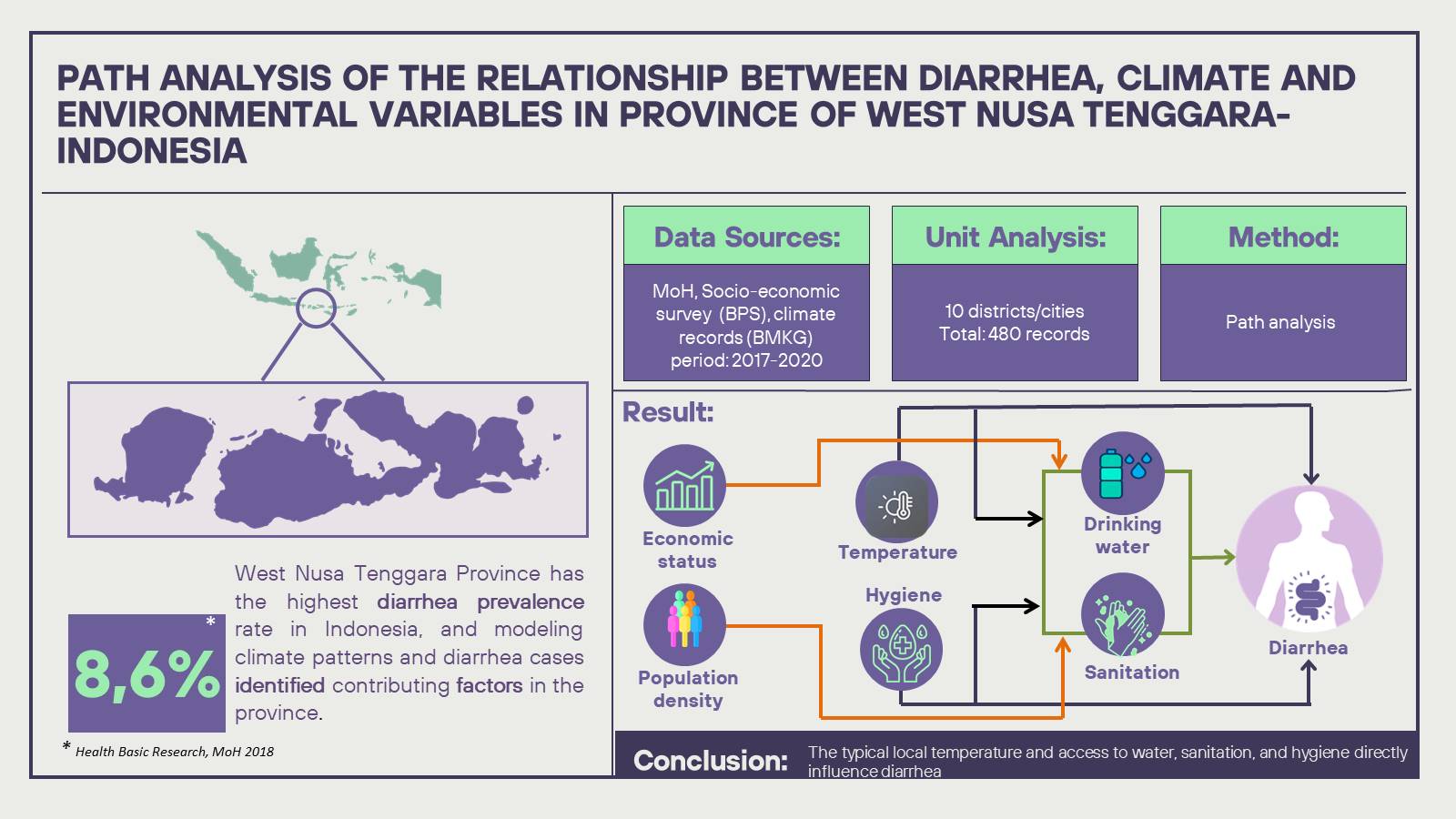Path Analysis of The Relationship between Diarrhea, Climate and Environmental Variables in Province of West Nusa Tenggara-Indonesia
Main Article Content
Abstract
Diarrhea is a major cause of morbidity and mortality, particularly in West Nusa Tenggara Province, Indonesia, due to certain factors. Therefore, this study aims to examine the influence of climate, economic status, demographic, water, sanitation, and hygiene factors on diarrhea. The study procedures were carried out using an ecological design that focused on the characteristics of the sample population. The unit of analysis was districts/cities, where data on diarrhea cases from 2017–2020 were used, along with other variables in the same period. The dependent variable was the number of diarrhea cases per month, while the independent variables included average temperature, economic status, population density, access to water, sanitation, and hygiene. A total of 480 records were analyzed descriptively using path analysis to determine the relationships between the variables. The results showed that average temperature had a significant direct relationship with diarrhea (b = 0.127, 95% CI = 0.027 – 0.227, p = 0.013;) and indirectly through unsafe drinking water-limited sanitation (b = 0.088, 95% CI = 0.001 – 0.175, p = 0.047). Economic status and population density were also reported to have a significant indirect effect, while unsafe drinking water-limited sanitation and limited hygiene had a direct influence (b = 0.166, 95% CI = 0.07 – 0.263, p = 0.001 and b = 0.124, 95% CI = 0.019 – 0.229, p = 0.021). In addition, the model also showed that water sanitation had a positive and significant correlation with hygiene. In summary, diarrhea was directly influenced by the average local temperature, access to water, sanitation, and hygiene. Indirectly, the average temperature played a significant role along with population density and economic status.
Article Details

This work is licensed under a Creative Commons Attribution-NonCommercial 4.0 International License.
Published articles are under the copyright of the Applied Environmental Research effective when the article is accepted for publication thus granting Applied Environmental Research all rights for the work so that both parties may be protected from the consequences of unauthorized use. Partially or totally publication of an article elsewhere is possible only after the consent from the editors.
References
WHO. Diarrheal disease. World Health Organization, 2017. [Online] Available from: https://www.who.int/news-room/fact-sheets/detail/diarrhoeal-disease [Accessed 20 November 2022].
Kementerian Kesehatan RI. Laporan Riset Kesehatan Dasar tahun 2018. Jakarta: Kemenkes RI. 2018.
Kementerian Kesehatan RI. Profil kesehatan Indonesia tahun 2020. Jakarta: Kemenkes RI; 2021
WHO. Quantitative risk assessment of the effects of climate change on selected causes of death 2030s and 2050s. Geneva: World Health Organization. 2014. [Online] Available from: https://iris.who.int/handle/10665/134014 [Accessed 13 September 2023].
IPCC. Climate Change 2021 The Physical Science Basis: Working Group I Contribution to the Sixth Assessment Report of the Intergovernmental Panel on Climate Change. 1st ed. Cambridge University Press. [Online] Available from: https://doi.org/10.1017/9781009157896
Aik, J.,Ong, J., Ng, LC. The effects of climate variability and seasonal influence on diarrhoeal disease in the tropical city-state of Singapore: A time-series analysis. International Journal of Hygiene and Environmental Health, 2020.
Saad,H. A,. Helmy, M.A., Ellaithy, L.S., Wheida, A., El Nazer, M., Alfaro S.C., Mostafa, A.M. Temporal trend of diarrhea morbidity rate with climate change: Egypt as a case study. Environmental Science and Pollution Research, 2023, 30(2),5059–5075.
Kemajou, D.N. Climate variability, water supply,sanitation and diarrhea among children under five in Sub-Saharan Africa: a multilevel analysis. Journal of Water and Health, 2022, 20(4):589–600.
WHO and UNICEF. Safely managed drinking water: thematic report on drinking water. Geneva: World Health Organization. 2017.
Ayuningrum, I.Y., Murti, B. Aplikasi Path Analysis dan Structural Equation Model dengan STATA. Karanganyar: Bintang Fajar Offset. 2019.
Finney, S.J., DiStefano, C. Non-normal and Categorical data in structural equation modeling. In G. r. Hancock &, R. O. Mueller. Structural equation modeling: a second course Connecticut: Information Age Publishing, 2006.
Hooper, D., Coughlan, J., Mullen, M.R. Structural Equation Modelling: Guidelines for Determining Model Fit. The Electronic Journal of Business Research Methods. 2008, 6(1), 53-60.
Crowson, M. Path analysis with manifest variables using STATA Part 1: The basics. 2023. [Online] Available from: https://drive.google.com/file/d/1x0D6HQJ8mFJjJQqpnXZloVNxdW44F40v/view [Accessed 16 August 2023].
Wang, P., Asare,E., Pitzer, V.E., Dubrow, R., Chen, K. Associations between long-term drought and diarrhea among children under five in low- and middle-income countries. Nature Communications, 2022,13(1): 3661.
UNICEF. Progress on household drinking water, sanitation and hygiene 2000-2022: Special focus on gender.United Nations Children’s Fund. [Online] Available from: https://data.unicef.org/resources/jmp-report-2023/?utm_id=JMP-2023 [Accessed 2 September 2023].
Kartika, D.S., Rahardjo, S.S., Murti, B. Multilevel Analysis on the Contextual Effects of Hygiene, Environmental Sanitation, and Diarrhea Prevention in Elementary School Students in Ngawi. East Java. Journal of Epidemiology and Public Health. 2019, 4(2): 97–108.
Tungga, T.M., Dewi, Y.L., Murti, B. Path Analysis: Psychososial and Economic Factors Affecting Diarrhea Incidence in Children under Five in Jayapura, Papua. Journal of Epidemiology and Public Health. 2018, 03(03): 331–341.
Pinzón-Rondón, Á.M., Zárate-Ardila, C., Hoyos-Martínez, A., Ruiz-Sternberg, Á.M., Vélez-van-Meerbeke, A. Country characteristics and acute diarrhea in children from developing nations: a multilevel study. BMC Public Health. 2015;15(1): 811
Anwar,M.Y., Warren, J.L., Pitzer, V.E. Diarrhea Patterns and Climate: A Spatiotemporal Bayesian Hierarchical Analysis of Diarrheal Disease in Afghanistan. The American Journal of Tropical Medicine and Hygiene. 2019;101(3): 525–533.

